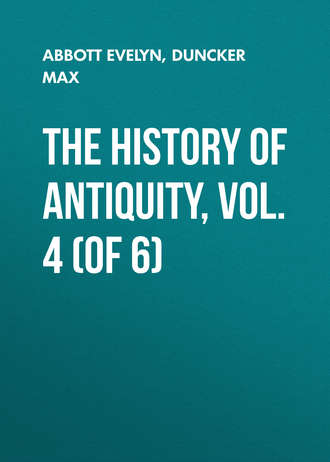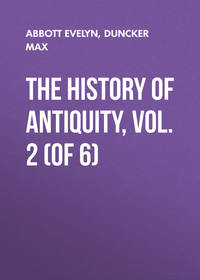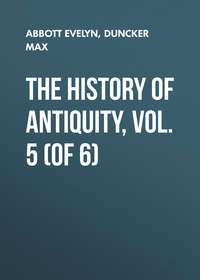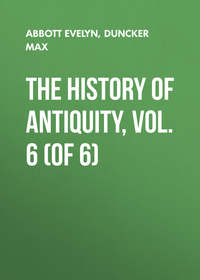 полная версия
полная версияThe History of Antiquity, Vol. 4 (of 6)
Thus the new system effaced the specific distinctions between plants and beasts, men and gods. Everywhere it saw nothing but spirits, which have to work their way in a similar manner from greater or less impurity to purity, from incompleteness to completeness and the original source of their existence. The souls, when they had once been created and had emanated from Brahman, found no rest or end till they had returned once more to this their starting-point; and this they were unable to do till they had been raised to the purity and sanctity of Brahman.
However indifferent the kings, nobles, and peasants may have been to this doctrine of the world-soul and Brahman, these new, severe, and terrible consequences, derived from it by the priests for the life after death, could not be without a deep impression. They operated with immense force on the spirit of the Indians. To endure the torments of hell in continuous heat, while even on earth the warmth of the climate was so hard to bear, was a terrible prospect. But even this appeared only as the lesser evil. Along with and after the torments of hell those who committed grievous sins had to expect a ceaseless regeneration in the bodies of men and animals until they had worked their way up to Brahman. At the same time the priests took care to impress upon the hearts of the people the fate which awaited those who did not follow their ordinances. They reminded them perpetually of "the casting of the soul into hell and hell-torments." The sinner was to think, "what migrations the soul would have to undergo owing to his sin; of the regeneration through ten thousand millions of mothers."178 These endless terrors and torments now in prospect for the man who did not fulfil the vocation assigned to him by the creator at birth, or the prescripts of the priests, were only too well adapted to win respect for their requirements. Who would venture to trespass on the divine arrangement of the world, according to which the first place was secured on earth to the Brahman in preference to the wealthy armed noble, the peasant, and the miserable Çudra, who was only on a level with the higher order of animals? Who would not look up with reverence to the purer incarnation of the world-soul, the holier spirit, which dwelt in the Brahmans? Even though the theory of the world-soul remained unintelligible to the many, they understood that the Brahmans, who busied themselves with sacrifice, prayers, and sacred things, stood nearer to the deity than they did; they understood that if they misconducted themselves towards the sacred race or disregarded the vocation of birth, they must expect endless torments in hell, and endless regenerations in the most loathsome worms and insects, or in the despised class of the Çudras – "those animals in human form."
The priesthood cannot have succeeded in making good their claims to superiority over the Kshatriyas, their new doctrine and ethics, without long-continued struggles and contests. If the two first centuries after the foundation of the states – the period between 1400 and 1200 B.C. – were occupied, as we assumed above, with the arrangement and consolidation of the new kingdom, the establishment of the position of the nobles, and the composition of songs of heroism and victory, we may assign to the next two centuries – from 1200 to 1000 B.C. – the sharper distinction of the Kshatriyas and Vaiçyas, the amalgamation of the families of minstrels and priests into an order; the rise of this order in the states on the Ganges as the preserver of the ancient faith and ancient mode of worship; the combination of the customs, formulæ, and invocations hitherto handed down separately in the separate states. If in the first period the immigrant Aryas separated themselves as a common race from the Çudras, in the next the three orders of the Aryas became distinguished. Only the man who was born a Kshatriya could partake in the honour of this order; only one who sprung from a family of priests could be allowed to assist in the holy acts of sacrifice; and he who was born a Vaiçya must continue to till the field.
At the beginning of the ensuing century —i. e. in the period from 1000 B.C. downwards – the priests, now in possession of all the ancient invocations and formulæ, may have begun their meditations with the comparison of the invocations, the attempt to find out the right meaning of them, and to grasp the unity of the divine nature. The hymns of the latest portion of the Vedas, which are obviously a product of these meditations, may perhaps have arisen in the first half of this period. From the mysterious secret of the worship, the spirit of prayer, and the idea of the mighty, ever-recurring stream of birth and decay in the land of the Ganges, the Brahmans arrived at the idea of Brahman, the world-soul, and from this deduced its consequences. We may with certainty presuppose a long and severe struggle of the nobles against the dominion of the priests – a struggle which went on for several generations. Even the Vaiçyas can hardly have submitted without resistance to all the requirements of the Brahmans. The impassable gulf between the orders, the exclusion of intermarriage, was only carried out, as we can show, with difficulty; and even the ethics of the new doctrine must have met with resistance.
We have already referred to the circumstances which rendered victory easier to the Brahmans, to the changed conditions of life, and the nature of the land of the Ganges. Another fact in their favour was that the new doctrines of the Brahmans did not attack the monarchy. This continued to remain in the order of the Kshatriyas, and no essential limitation of their powers was required by the new doctrine from the princes on the Ganges. It is true that it demanded recognition of the superiority of the Brahmans to the other orders, and acknowledgment of the special sanctity of the order even from the kings; it required reverence, respect, and liberality, towards the Brahmans; yet in all other respects the new system was calculated to increase rather than diminish the power of the kings. The rule of unconditional submission to the existing order must have strengthened considerably the authority of the kings, and assisted them in removing the limitations hitherto, without doubt, imposed upon them by the importance of the Kshatriyas; and we can hardly avoid the conclusion that the kingdom on the Ganges was first raised by the new doctrine to absolute power; on this foundation it became a despotism.
We may feel confident in assuming that the victory of the Brahmans in the land of the Ganges was completed about the time when the dynasty of the Pradyotas ascended the throne of Magadha, i. e. about the year 800 B.C.179 The districts from the Sarasvati eastward as far as the upper Ganges are after that time a sacred land to the Indians. The country between the Sarasvati and the Drishadvati is called Brahmavarta, i. e. Brahma-land. Kurukshetra (between the Drishadvati and the Yamuna), the districts of the Bharatas and Panchalas, of the Matsyas and Çurasenas, i. e. the entire doab of the Yamuna and the Ganges, are comprised under the name Brahmarshideça, i. e. the land of the holy sages. Here were situated the famous residences of the Kurus and Pandus, Hastinapura, Indraprastha, Kauçambi, and on the confluence of the Yamuna and Ganges, Pratishthana; here, finally, was the city of Krishna, Krishnapura, and the sacred Mathura on the Yamuna; and elsewhere also in this district we find consecrated places and shrines of pilgrimage. It is maintained that the bravest Kshatriyas and the holiest priests are to be found in this district; the customs and observances here are regarded as the best, and as giving the rule to the remainder. The law-book of the priests requires that every Arya shall learn the right walk in life from a Brahman born in Brahmarshideça, and that, properly, all Aryas should live there.180 It cannot have been any reminiscence of the great war which caused the priests to set such a value on these regions, and make these demands, nor even the fact that these districts were the first occupied by the emigrants from the Indus, so that here first in the new country were consecrated places set up for the worship of the immigrants, and the least intermixture took place with the ancient population. It is due rather to the fact that in these regions the civilisation and culture of the Indians were consolidated in an especial degree; here the priestly reform of the religion, if it did not receive the first impulse, yet acquired the victory and became supreme, owing perhaps to the support of the princes of the dynasty of Pandu, who reigned at Kauçambi. As these were the regions in which the priests first regulated the ancient customs of worship, morals, and justice according to the new doctrine, they could afterwards serve as a pattern for all the rest. If the Brahmans, soon after they had succeeded in carrying through their demands here, revised the Epos of the great war in the light of their new system, they could claim the thanks of the kings of the Bharatas for their support, they could show that the kings who in ancient times had won the dominion in these lands, the ancestors of the race then on the throne, had even in early times obediently followed the commands of the priests, and they could set up the conquerors in that struggle as patterns of the proper conduct of kings to Brahmans (p. 101).
Hence we may perhaps assume that it was in the districts on the upper Yamuna and the upper Ganges that the priesthood first got the upper hand, and the same change followed in the lands still further to the east, after the great priestly families, with more or less difficulty, delay and completeness, established themselves among the Kshatriyas of these districts – the Vasishthas with the kings of the Koçalas, the Gautamas with the kings of the Videhas, to whom no doubt they made very clear the services their forefathers had rendered to the predecessors on the throne. According as the previous circumstances offered more resistance in one place, and less in another, the new system was sometimes carried out more rapidly and thoroughly, and at others more slowly and with less severity.
No historical tradition has come down to us of the resistance made by the nobles to the priestly order in defence of their possession, or by the kings in questions affecting their power. It was the interest of the Brahmans to establish and describe the position they had won by conquest as occupied by them from the first. No nation has gone so far as the Indians in their eagerness to forget the old condition of affairs in every succeeding evolution, and to establish the new point of view as one existing from the first. The liveliness and force of their fancy must have unconsciously led them to regard the new and the present as the old and the original after comparatively short intervals of time.
In some episodes of the Epos and narratives of the Puranas we find legends of kings and warriors who because they did not show the proper respect for the Brahmans, or opposed them, were severely punished, and of saintly heroes who slew the Kshatriyas. We cannot, however, assume, that in the one or the other there is concealed any historic reminiscence. They are merely intended to set up terrifying examples of the lot which awaited kings and Kshatriyas who ventured to disregard the Brahmans. The book of the law tells us that the wise king Vena became infirm in mind owing to sensuality, and in this condition he brought about the mixture of the orders.181 King Nahusha, Sudas, the son of Pijavana, and Nimi perished through want of humility, but Viçvamitra by his humility was raised to the rank of a Brahman.182 All these names are taken from the legend as it existed previously to the great war.
In the Rigveda, Vena is mentioned as the father of Prithu;183 the Ramayana enumerates Vena and his son Prithu among the first successors of Ikshvaku, the progenitor of the kings of the Koçalas (p. 106). The Vishnu-Purana, which assigns the same position to Vena, tells us that he took upon himself to arrange the duties of men, and forbade the Brahmans to sacrifice to the gods; no one might be worshipped but himself. Then the holy Brahmans slew the sinner with swords of the sacred sacrificial grass, which had been purified by invocations. And when, on the death of the king, robbers sprung up on every side, the Brahmans rubbed the right arm of the dead king, and from it sprung the pious and wise Prithu, who shone like Agni; he ruled between the Yamuna and Ganges, and subdued the earth, and by this noble son Vena's soul was freed from hell. The Mahabharata tells us that Prithu inquired with folded hands of the great saints about his duties, and that they bade him maintain the Veda, abstain from punishing Brahmans, and protect society from the intermixture of the castes.184
King Nahusha belongs to the royal race of the Bharatas; he is mentioned as the second successor of Pururavas (p. 82). The Mahabharata tells us that he was a mighty king, but he laid tribute on the saints, and forced them to carry him. Once he caused his palanquin to be carried by a thousand great sages, and because they did not go fast enough, he struck with his foot the holy Agastya who was among them. Then Agastya cursed him and he was changed into a serpent.185
Nimi, according to the Ramayana, is a son of Ikshvaku, the progenitor of the Koçalas. He bade Vasishtha his priest offer a sacrifice for him, and Vasishtha undertook to perform the second half of it. But the king caused the sacrifice to be offered by another saint, by Gautama. When Vasishtha heard this he pronounced a curse on Nimi that he should lose his body, and Nimi forthwith died. He was not punished for rebellion against a Brahman, but because he had not submitted himself with absolute obedience to his own priest.
Lastly Viçvamitra is said to have obtained the rank of a Brahman by humility. Viçvamitra is known to us from the hymns of the seventh book of the Rigveda as offering sacrifice for the Bharatas, while Vasishtha or his race offer prayer and sacrifice for their opponent, Sudas, the king of the Tritsus, who afterwards settle on the Sarayu and bear the name of Koçalas (p. 66). But the Ramayana and the Puranas also place Vasishtha at the side of the kings of the Koçalas, not at the time of Nimi only, as we have seen, who is the son of the tribal ancestor Ikshvaku, but at the side of Ikshvaku's descendants in the fifth century, like Vena, and even in the twentieth and fiftieth generations. The imagination of the Indians was not disturbed by such things in the case of a great priest of the old time. Yet in other parts of the Rigveda besides those quoted above, in the third book, we find prayers offered by Viçvamitra for Sudas, and some obscure expressions may be regarded as curses directed by Vasishtha against Viçvamitra. From the circumstance that Viçvamitra at one time offers prayers for the king of the Tritsus, and at another for the king of the Bharatas, we may draw the conclusion, that the family of the Kuçikas to which Viçvamitra belonged was driven out among the Tritsus by another family – that of Vasishtha, and that afterwards the Kuçikas offered their services to the kings of the Bharatas, and were allowed to perform them. Out of the opposition of Viçvamitra and Vasishtha, indicated in the Rigveda, the priestly literature of the Indians has invented a great contest between Viçvamitra and the Kshatriyas, in order to bring to light the superiority of the Brahmans. Even with the aid of his weapons, Viçvamitra the Kshatriya cannot prevail against the Brahman Vasishtha. At length he recognises the majesty of the Brahman, submits to Brahmanic ordinances, and distinguishes himself by sanctity to such a degree "that he became like a Brahman, and possessed all the qualifications of one."186
In the Vishnu-Purana Sudas is the fiftieth successor of Ikshvaku on the throne of the Koçalas. His priest was Vasishtha; and Viçvamitra, the son of a great Kshatriya, the king of Kanyakubja (Kanoja), wished to drive him out. One day, while hunting, Sudas met a Brahman, who would not move out of the way for him, and he struck him with his whip. The Brahman was Çakti, the eldest of Vasishtha's hundred sons. Çakti pronounced on the king the curse that he should become a cannibal, and the curse was fulfilled. But by the help of an evil spirit Viçvamitra was able to bring the consequences of the curse on the sons of Vasishtha; Çakti himself and all his brothers were eaten by the king. In despair at the death of his sons, Vasishtha sought to put an end to his own life, but in vain. When at length he returned to his settlement, he found that the widow of his eldest son was pregnant; and when she brought forth Paraçara the hope of progeny revived in him. But Sudas desired to eat Paraçara also. Then the holy Vasishtha blew on Sudas, sprinkled him with holy water, and took the curse from him, and in return the king promised never to despise Brahmans, to obey their commands, and show them all honour. And when Paraçara grew up, and wished to avenge the death of his father, Vasishtha told him that under the rule of Kritavirya (he is said to have reigned over a tribe of the Yadavas) the Bhrigus, the priests of the king, had become rich in corn and gold by his liberality. Arjuna, the successor of Kritavirya, had fallen into distress, and sought aid from the Bhrigus. Then some of them buried their possessions out of fear of the Kshatriyas, and when by accident a Kshatriya discovered the treasure hidden in the house of a Bhrigu they slew all the Bhrigus. But their widows fled to the Himalayas, and there one of them brought forth Aurva, who desired to avenge the death of the Bhrigus by the slaughter of the Kshatriyas. But the spirits of the holy Bhrigus warned him to give up his passion, and curb his anger; by concealment they had roused the anger of the Kshatriyas, in order to arrive the sooner in heaven. In like manner Paraçara abandoned the idea of avenging his father.
No greater historical value is to be attached to a legend of the destruction of the Kshatriyas by a Brahman. Gadhi, the father of Viçvamitra, had given his daughter to wife to a saint, Richika, the son of Aurva, of the race of the Bhrigus. She bore Jamadagni to Richika, who lived as an eremite after the example of his father. One day Arjuna came to the abode of Jamadagni, and though he received the king with honour, Arjuna caused the calf of his cow to be carried away. Then Paraçurama, i. e. Rama with the axe, the youngest son of Jamadagni, slew the king, and the king's sons slew Jamadagni. To avenge the death of his father, Paraçurama swore to destroy all the Kshatriyas from the earth. Thrice seven times with his irresistible axe he cut down the Kshatriyas, and appeased the manes of Jamadagni and the Bhrigus with the blood of the slain. Then he offered a great sacrifice to Indra, and presented the earth to the saint Kaçyapa. But Kaçyapa gave it to the Brahmans, and went into the forest. Then the stronger oppressed the weaker, and the Vaiçyas and Çudras behaved themselves wickedly towards the wives of the Brahmans, and the earth besought Kaçyapa for a protector and a king; a few Kshatriyas were still left among the women; and Paraçara had brought up Sarvakarma, the son of Sudas. And Kaçyapa did as the earth entreated him, and made the son of Sudas and the other Kshatriyas to be kings. This was long before the great war.187 In the Ramayana, Paraçurama rebels when Rama has broken Çiva's great bow. All were in terror lest he should again destroy the Kshatriyas. But Rama also strings Paraçurama's great bow, shoots the arrow to the sky, not towards Paraçurama, "because he was a Brahman," and Paraçurama returned to Mount Mahendra.
CHAPTER V.
THE OLD AND THE NEW RELIGION
In the land of the Ganges the Brahmans had gained a great victory and carried out a great reform. A new god had thrown the old gods into the background, and with the conception of this new god was connected a new view of the world, at once abstract and fantastic. From this in turn followed a new arrangement of the state, and of the orders, which were now of divine origin, as direct products of creation, and thus became irrevocably fixed. The monarchy itself was of humbler descent than the Brahmans, the first of the earth; to them the warlike nobles were made inferior, while the doctrines of hell and regeneration, which the Brahmans put in the place of the old ideas of life after death, must gradually have brought about the subjugation of the national mind and heart to the new religion.
When the Brahmans succeeded in establishing their claims in the land of the Ganges about the year 800 B.C. (as we ventured to assume), the old sacrificial songs and invocations, which they had imported with them from the land of the Indus, were no doubt to a great extent already written down. When the various families of minstrels and priests had first exchanged with each other their special treasures of ancient prayers; when the Brahmans, passing beyond the borders of the separate states, had become amalgamated into one order, and had thus consolidated the existing stock of traditional formulæ and ritual – it must have been felt necessary to preserve this valuable treasure in its greatest possible extent, and, considering the belief of the Aryas in the magical power of these forms, as securely as possible from any change. Whatever might be the assistance which the compact form of these invocations lent to the memory, the body of songs which had now passed from tradition and the possession of the separate families into the general possession of the orders, was too various and comprehensive, – minute and verbal accuracy was too important, – for the resources of even the most careful oral teaching, the strongest and most practised memory. But the process of writing them down was not accomplished at once. In the first case, no doubt, each family added to its own possessions the store of the family most closely connected with it.188 Beginning from different points, after manifold delays, extensions, and enlargements from the invocations first composed in the land of the Ganges, which allow us to trace the change from the old views to the new system, the collection must at last have comprised all that was essential in the forms and prayers used at offerings and sacrifices.
We do not know how far back the use of writing extends with the Indians. According to the account of Nearchus, they wrote on cotton, beaten hard; other Greeks speak of the bark of trees, while native evidence teaches us that the leaves of the umbrella palm were used for the purpose. Modern enquirers are of opinion that the Indian alphabet is not an invention of the people, but borrowed from the Phenician.189 As we have shown, the Phenicians reached the mouth of the Indus in the tenth century. But about this time, or perhaps before it, there existed a marine trade between the Indians and Sabæans, on the coasts of south Arabia. Granting the origin of the Indian alphabet from the Phenician, it is thus rendered more probable that it was taken from the south Arabian alphabet, which in its turn rose out of the Aramaic alphabet, than that it was borrowed directly from the Phenician. In the latter case we should have to presuppose a trade between Babylonia and India by means of the Persian Gulf (in Babylonia the Aramaic alphabet was in use beside the cuneiform in the eighth century B.C. at the latest) as a more probable means of communication than the voyages of the Phenicians to Elath, which had already been given up. But from whatever branch of the Semitic races the Indian letters may have been taken, the general use of them cannot be put much earlier than 800 B.C. The oldest inscriptions of the Indians which have come down to us, are those of Açoka, king of Magadha, and belong to the middle of the third century B.C. They exhibit a complete alphabetic use of writing, and the forms of the letters are not very different from those employed at a later time.190
Among the Indians the collection of their old songs and forms is known as the Veda, i. e. knowledge: it forms the knowledge of the priest. We possess these songs in three groups. The oldest, and no doubt the original group, the Rigveda, i. e. the knowledge of thanksgiving, comprises in ten books more than a thousand of the traditional poems and sacrificial songs. For the most part they are arranged according to a certain recurring order in the deities invoked; and, as we have seen, some poems are included which could never have been sung at sacrifices at all. Besides this collection there are two collections of the liturgic prayers which ought to accompany the performance of sacrifice. The Samaveda comprises the prayers sung at the offering of the soma; they are verses taken from the Rigveda, and the collection is a book of songs or hymns.191 The Yajur-veda contains the formulæ and ritual which must be chanted at the dedication of the altar, the kindling of the fire, and every act of every sacrifice. Thus the Samaveda supplied the knowledge of the Udgatar, the prayers during the sacrifice of soma, the Yajur-veda supplied the knowledge of the Adhvaryu, who had to perform the material part of the sacrificial service, the ritual for the separate acts of the ceremony. Compared with these two books the Rigveda was the book of the Hotar, i. e. of the chief priest, who had to conduct the sacrifice, and invoke the gods to come down to it.192 If in the parts of the hymns of praise and invitations, which are repeated from the Rigveda in the Samaveda, the style and tone is often more archaic than in the Rigveda, the explanation is that the prayer at the sacrifice was no doubt preserved with more liturgic accuracy, than the invitation to the god, which preceded the sacrifice. The Yajur-veda is preserved in a double form; of which one, the black Yajus, is shown to be the older by its want of systematic sequence; but even in this older form we find, as in the tenth book of the Rigveda,193 pieces of later origin, the outcome of priestly meditation.






